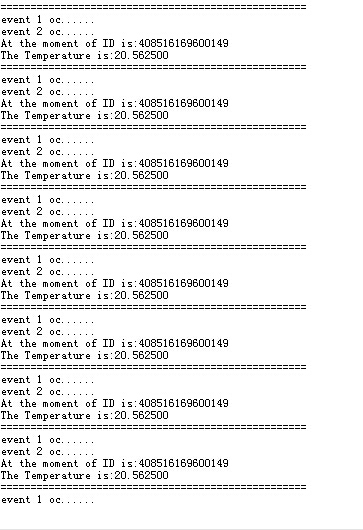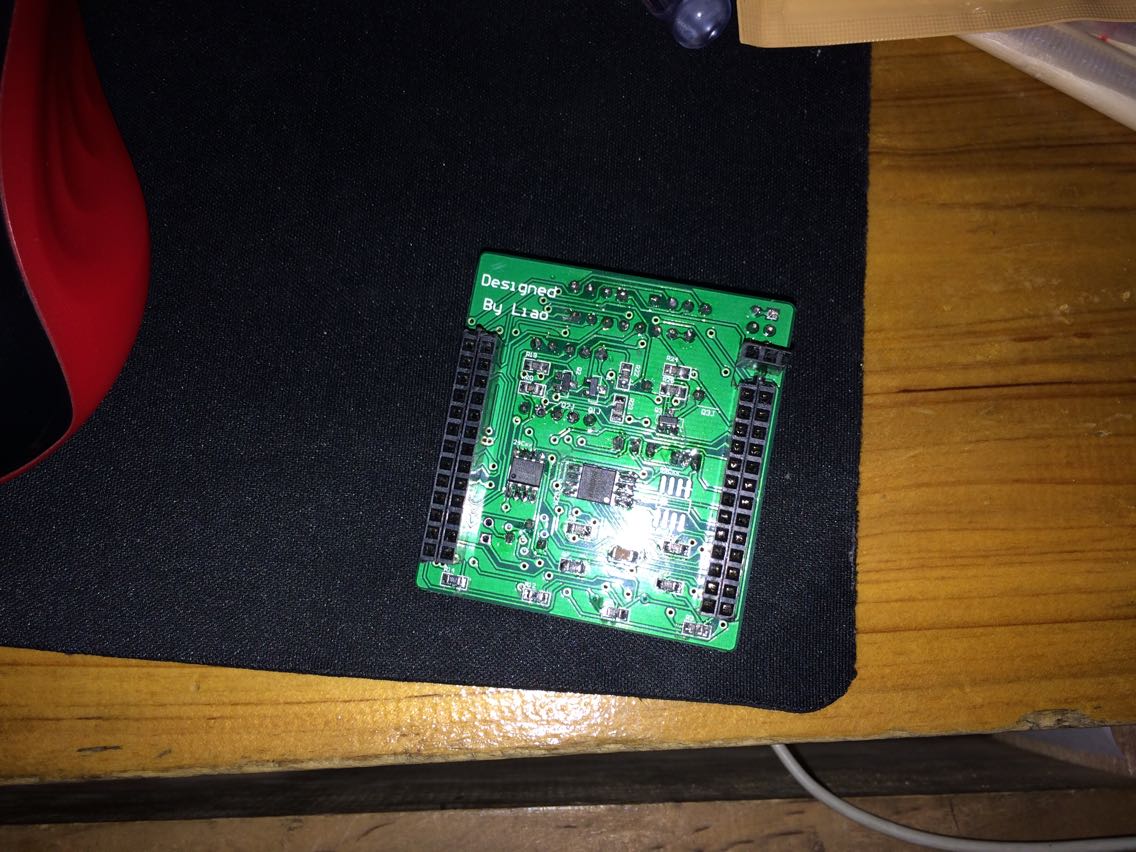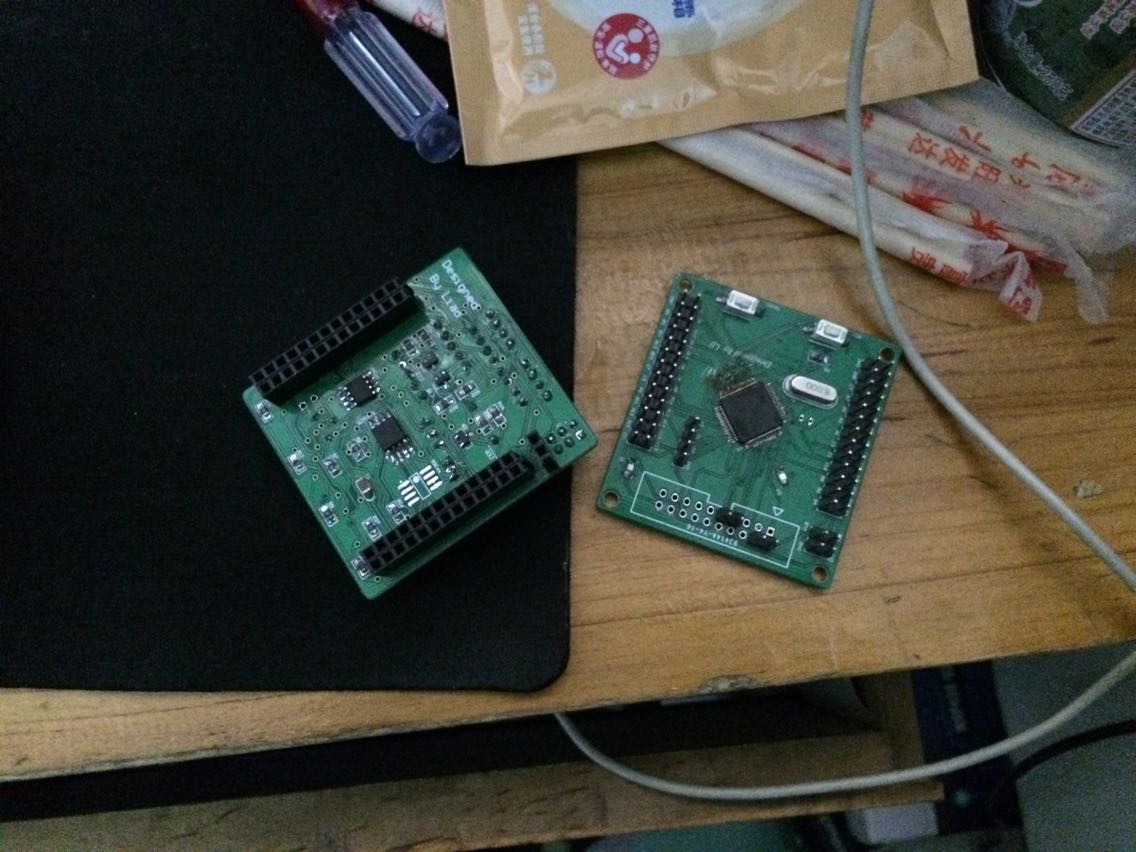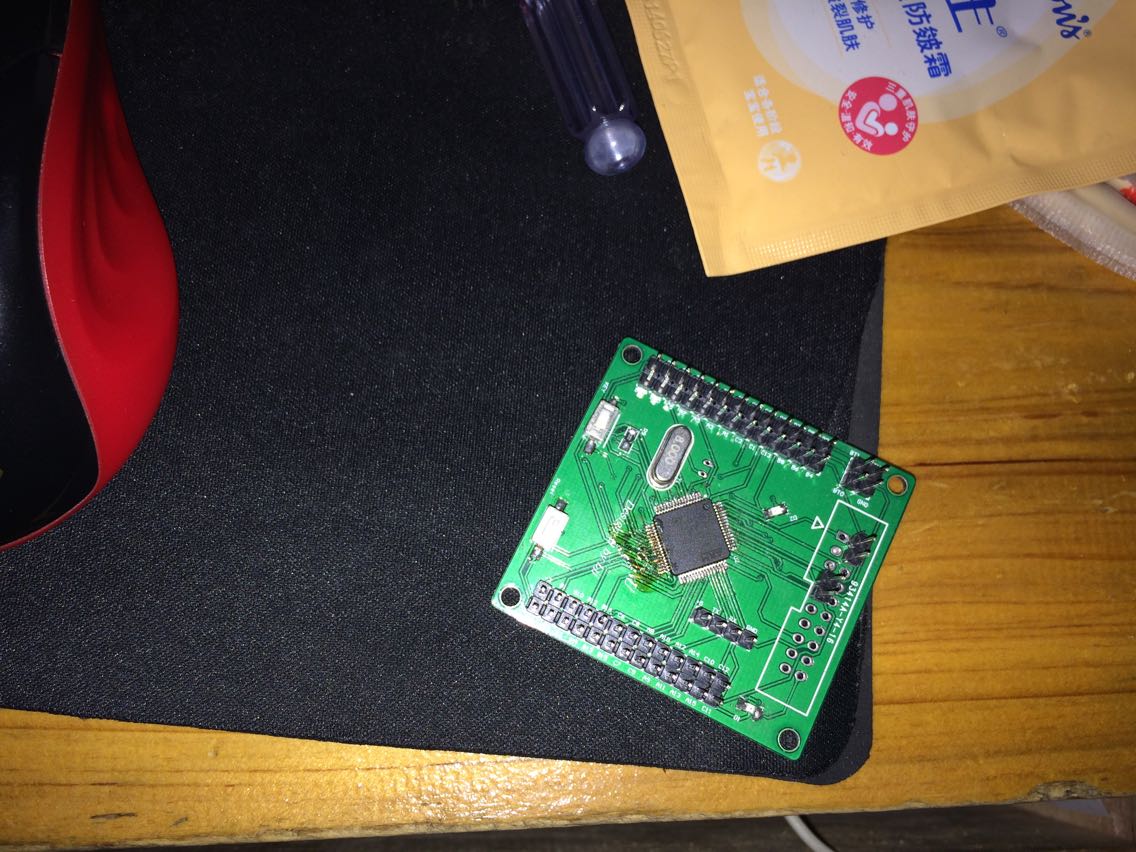
/* Includes ------------------------------------------------------------------*/
03.#include "stm32f10x.h"
04.#include "stm32_eval.h"
05.#include
06.
07.volatile int flag;
08.#define Set_B20() GPIO_SetBits(GPIOC, GPIO_Pin_12) //上拉关闭PC12
09.#define Reset_B20() GPIO_ResetBits(GPIOC, GPIO_Pin_12) //下拉打开PC12
10.#define Read_B20() GPIO_ReadInputDataBit(GPIOC,GPIO_Pin_12) //读PC12状态
11.unsigned char Error_Flag=0;
12.unsigned char zf=0;
13.void SysTick_Configuration(void)
14.{
15. /* Setup SysTick Timer for 10 msec interrupts */
16. if (SysTick_Config(48000)) //SysTick配置
17. {
18. /* Capture error */
19. while (1);
20. }
21. /* Configure the SysTick handler priority */
22. NVIC_SetPriority(SysTick_IRQn, 0x0); //SysTick中断优先级
23.}
24.
25.
26./** @addtogroup STM32F10x_StdPeriph_Examples
27. * @{
28. */
29.
30./** @addtogroup EXTI_Config
31. * @{
32. */
33.
34./* Private typedef -----------------------------------------------------------*/
35./* Private define ------------------------------------------------------------*/
36./* Private macro -------------------------------------------------------------*/
37./* Private variables ---------------------------------------------------------*/
38.GPIO_InitTypeDef GPIO_InitStructure; //结构体的命名
39.USART_InitTypeDef USART_InitStructure; //结构体的命名
40.USART_ClockInitTypeDef USART_ClockInitStructure; //结构体的命名
41.
42.void RCC_Configuration(void)
43.{
44. RCC_DeInit(); //将外设RCC的所有寄存器重新设为缺省值
45.
46. RCC_HSICmd(ENABLE); //使能内部高速晶振
47. while(RCC_GetFlagStatus(RCC_FLAG_HSIRDY) == RESET); //当SHI晶振就绪则重新设定
48.
49. RCC_SYSCLKConfig(RCC_SYSCLKSource_HSI); //设置系统时钟,选择SHI时钟为系统时钟
50.
51. RCC_HSEConfig(RCC_HSE_OFF); //设置外部高速晶振,HSE晶振OFF
52. RCC_LSEConfig(RCC_LSE_OFF); //设置外部低速晶振,LSE晶振OFF
53.
54. //******配置PLL时钟频率为48MHZ*******//
55.
56. RCC_PLLConfig(RCC_PLLSource_HSI_Div2,RCC_PLLMul_8); //RCC_PLLMul_x 即设置PLL时钟频率为 6*x MHz
57.
58. //************************************//
59.
60. RCC_PLLCmd(ENABLE); ////*******************使能PLL
61. while(RCC_GetFlagStatus(RCC_FLAG_PLLRDY) == RESET); //PLL就绪
62. RCC_ADCCLKConfig(RCC_PCLK2_Div4); // ADC时钟=PCLK/2
63. RCC_PCLK2Config(RCC_HCLK_Div1); // APB2时钟=HCLK
64. RCC_PCLK1Config(RCC_HCLK_Div2); /// APB1时钟=HCLK/2
65. RCC_HCLKConfig(RCC_SYSCLK_Div1); // AHB时钟=系统时钟
66. RCC_SYSCLKConfig(RCC_SYSCLKSource_PLLCLK); // 选择PLL为系统时钟
67. while(RCC_GetSYSCLKSource() != 0x08); //当PLL不是系统时钟
68.
69.
70.// SystemInit();
71.
72. RCC_APB2PeriphClockCmd(RCC_APB2Periph_GPIOD|RCC_APB2Periph_AFIO, ENABLE); //使能APB2外设时钟/****GPIOD时钟和功能复用IO时钟***/
73. GPIO_PinRemapConfig(GPIO_Remap_SWJ_JTAGDisable,ENABLE);//disable JTAG SW_DP使能
74.RCC_APB2PeriphClockCmd(RCC_APB2Periph_GPIOD|RCC_APB2Periph_AFIO, ENABLE);
75. GPIO_PinRemapConfig(GPIO_Remap_SWJ_JTAGDisable,ENABLE);//disable JTAG
76. GPIO_InitStructure.GPIO_Pin = GPIO_Pin_2; // //选择设置GPIO管脚
77. GPIO_InitStructure.GPIO_Speed = GPIO_Speed_50MHz; ////设置管脚速率
78. GPIO_InitStructure.GPIO_Mode = GPIO_Mode_Out_PP; ////设置管脚工作状态,此为推挽输出
79. GPIO_Init(GPIOD, &GPIO_InitStructure); //初始化GPIOD
80. GPIO_ResetBits(GPIOD,GPIO_Pin_2); //上拉关闭蜂鸣器
81. RCC_APB2PeriphClockCmd(RCC_APB2Periph_GPIOC|RCC_APB2Periph_AFIO, ENABLE);
82. GPIO_PinRemapConfig(GPIO_Remap_SWJ_JTAGDisable,ENABLE);//disable JTAG
83. GPIO_InitStructure.GPIO_Pin = GPIO_Pin_0|GPIO_Pin_1|GPIO_Pin_2|GPIO_Pin_3|GPIO_Pin_4|GPIO_Pin_5|GPIO_Pin_6|GPIO_Pin_7;//LED
84. GPIO_InitStructure.GPIO_Speed = GPIO_Speed_50MHz;
85. GPIO_InitStructure.GPIO_Mode = GPIO_Mode_Out_PP;
86. GPIO_Init(GPIOC, &GPIO_InitStructure);
87. GPIO_SetBits(GPIOC,GPIO_Pin_0|GPIO_Pin_1|GPIO_Pin_2|GPIO_Pin_3|GPIO_Pin_4|GPIO_Pin_5|GPIO_Pin_6|GPIO_Pin_7); // GPIOC.0到GPIOC.7输出胃叩缙姜
88. RCC_APB1PeriphClockCmd(RCC_APB1Periph_TIM2, ENABLE); //使能TIM2时钟
89.}
90.
91.void USART_int(long BaudRate)
92.{
93. RCC_APB2PeriphClockCmd(RCC_APB2Periph_GPIOA|RCC_APB2Periph_USART1,ENABLE);//使能GPIOA、USART1外设时钟
94. GPIO_InitStructure.GPIO_Pin = GPIO_Pin_9;
95. GPIO_InitStructure.GPIO_Speed = GPIO_Speed_50MHz; //GPIO的输出速率为50MHz
96. GPIO_InitStructure.GPIO_Mode = GPIO_Mode_AF_PP;
97. GPIO_Init(GPIOA, &GPIO_InitStructure);
98. /* PA10 USART1_Rx */
99. GPIO_InitStructure.GPIO_Pin = GPIO_Pin_10;
100. GPIO_InitStructure.GPIO_Mode = GPIO_Mode_IN_FLOATING; //使能外设GPIOC端口时钟
101. GPIO_Init(GPIOA, &GPIO_InitStructure);
102. /* USARTx configured as follow:
103. - BaudRate = 115200 baud
104. - Word Length = 8 Bits
105. - One Stop Bit
106. - No parity
107. - Hardware flow control disabled (RTS and CTS signals)
108. - Receive and transmit enabled
109. */
110. USART_InitStructure.USART_BaudRate = BaudRate;//设置USART传输波特率 BaudRate = 9600 可以直接写9600
111. USART_InitStructure.USART_WordLength = USART_WordLength_8b;//一帧传输或者接收的数据位数为8bit
112. USART_InitStructure.USART_StopBits = USART_StopBits_1;//在帧结尾传输一个停止位
113. USART_InitStructure.USART_Parity = USART_Parity_No;//奇偶模式失能
114. USART_InitStructure.USART_HardwareFlowControl = USART_HardwareFlowControl_None;//硬件流控制失能
115. USART_InitStructure.USART_Mode = USART_Mode_Rx | USART_Mode_Tx;//使能接收发模式
116. USART_ClockInitStructure.USART_Clock = USART_Clock_Disable; //时钟低电平活动
117. USART_ClockInitStructure.USART_CPOL = USART_CPOL_Low; //引脚时钟输出低电平时钟
118. USART_ClockInitStructure.USART_CPHA = USART_CPHA_2Edge; //第二个时钟边沿开始捕获数据
119. USART_ClockInitStructure.USART_LastBit = USART_LastBit_Disable;//最后一位数据的时钟脉冲不从SCLK输出
120. USART_ClockInit(USART1, &USART_ClockInitStructure); //引用结构体的成员
121. USART_Init(USART1, &USART_InitStructure);//USART1初始化
122. USART_Cmd(USART1, ENABLE);//使能USART1时钟外设
123. USART_ITConfig(USART1, USART_IT_RXNE, ENABLE);//使能接受中断
124. USART_Cmd(USART1, ENABLE); //使能 USART
125.}
126.
127.void delay_18b20(u32 nus) //18b20按照严格的时序工作,这是特定的一个延时函数(自定义)
128.{
129. u16 i;
130. while(nus--)
131. for(i=12;i>0;i--);
132.}
133.
134.
135.
136.void Init18B20(void) //18B20初始化
137.{
138. u8 aa=0;
139. u8 count =0;
140. RCC_APB2PeriphClockCmd(RCC_APB2Periph_GPIOC, ENABLE);//使能PC时钟
141. GPIO_InitStructure.GPIO_Pin = GPIO_Pin_12; //配置端口GPIOC.12
142. GPIO_InitStructure.GPIO_Mode = GPIO_Mode_Out_OD;//开漏输出
143. GPIO_Init(GPIOC, &GPIO_InitStructure); //引用结构体的变量
144. Set_B20() ; // GPIO_SetBits(GPIOC, GPIO_Pin_12)
145. delay_18b20(1);
146. Reset_B20(); //重置18B20
147.
148.
149. delay_18b20(480);
150. Set_B20();
151.// delay_18b20(500);
152. delay_18b20(480);
153.
154. count=0;
155. aa=Read_B20(); //温度读取
156. /****个人认为限制温度不超过99度,作为一个保护*/
157. while(!aa && count<100) //判断aa的非和计数器count的值是否都小于100
158. {
159. aa=Read_B20(); //
160. count++; //count自加1
161. }
162. if(count>=99)
163. Error_Flag=1; //错误返回值1
164. else
165. Error_Flag=0; //错误返回值0
166.
167.}
168.
169.unsigned char Read18B20(void)//按位读取数据
170.{
171.unsigned char i=0;
172.unsigned char date=0;
173.u8 tempp;
174. for(i=8;i>0;i--)
175. {
176.
177. Reset_B20(); //打开PC12
178. date>>=1; //标志右移一位
179. delay_18b20(1);
180. Set_B20(); //关闭
181. delay_18b20(1);
182. tempp=Read_B20(); //读取温度
183.
184. if(tempp) //判断tempp是否为1
185. date|=0x80; // 1000 0000 将最高位填1 ,然后右移,每次最高位由0变1,使8位全部传递完毕 0xff = 1111 1111
186. delay_18b20(60); //延时
187. }
188. return(date); //返回值是无符号的字符型的类型 date
189.}
190.void Write18B20(unsigned char date)//向18b20写数据
191.{
192. unsigned char i=0;
193.
194. for (i=8; i>0; i--)
195. {
196. Reset_B20();
197. delay_18b20(1);
198. if(date & 0x01)
199. {
200. Set_B20();
201. }
202. else
203. { Reset_B20();}
204. delay_18b20(60);
205. date>>=1;
206. Set_B20();
207. delay_18b20(1);
208.
209. }
210. delay_18b20(15);
211.}
212.
213. float Read_T()//读温度
214.{
215. unsigned char TUp,TDown;
216. unsigned char fTemp;
217. u8 TT=0;
218.
219. float Temp = 0;
220. Init18B20();
221. Write18B20(0xcc);
222. Write18B20(0x44);
223. Init18B20();
224. Write18B20(0xcc);
225. Write18B20(0xbe);
226. TDown = Read18B20();
227. TUp = Read18B20();
228.
229. if(TUp>0x7f)
230. {
231. TDown=~TDown;
232. TUp=~TUp+1;
233. TUp/=8;
234. zf=1;
235. }
236. else
237. zf=0;
238.
239. fTemp=TDown&0x0f;
240. TUp<<=4;
241. TDown>>=4;
242. TT=TUp|TDown;
243. Temp=TT+(float)fTemp/16;
244. return(Temp);
245.}
246.
247.int main(void)
248.{
249.
250. /*!< At this stage the microcontroller clock setting is already configured,
251. this is done through SystemInit() function which is called from startup
252. file (startup_stm32f10x_xx.s) before to branch to application main.
253. To reconfigure the default setting of SystemInit() function, refer to
254. system_stm32f10x.c file
255. */
256.
257. /* System Clocks Configuration */
258. char AddressID[10]; //定义一个字符型数组,长度为10
259. int i;
260. RCC_Configuration(); //配置RCC时钟
261. USART_int(115200); //波特率的设置
262. SysTick_Configuration(); //系统滴答时钟的调用
263. printf(" config done...\r\n"); //打印输出
264. //delay_ms(1000);
265.
266. Init18B20(); //初始化18b20;
267. Write18B20(0x34); //写入读取地址的命令
268. delay_18b20(20); //延时
269.
270. while(1)
271. {
272. if(flag == 300) //判断flag是否等于300
273. {
274. printf(" the AddressID is:") ;
275. for(i=0;i<10;i++) //字符不能直接输出,要按位输出
276. {
277. AddressID[i] = Read18B20();//读取地址
278. printf("%u", AddressID[i]);//输出地址
279. }
280. printf("\r\n") ; //换行
281. }
282. if(flag == 500) //判断flag是否等于500
283. {
284. printf("The Temperature is:%f\r\n",Read_T());//读取温度并输出
285.
286. printf("===================================================\r\n");
287. }
288. }
289.}
290.
291.
292.
293.#ifdef USE_FULL_ASSERT
294.
295./**
296. * @brief Reports the name of the source file and the source line number
297. * where the assert_param error has occurred.
298. * @param file: pointer to the source file name
299. * @param line: assert_param error line source number
300. * @retval None
301. */
302.void assert_failed(uint8_t* file, uint32_t line)
303.{
304. /* User can add his own implementation to report the file name and line number,
305. ex: printf("Wrong parameters value: file %s on line %d\r\n", file, line) */
306.
307. /* Infinite loop */
308. while (1)
309. {
310. }
311.}
312.
313.#endif
314.
315./**
316. * @}
317. */
318.
319./**
320. * @}
321. */
322.
323.#ifdef __GNUC__
324. /* With GCC/RAISONANCE, small printf (option LD Linker->Libraries->Small printf
325. set to 'Yes') calls __io_putchar() */
326. #define PUTCHAR_PROTOTYPE int __io_putchar(int ch)
327.#else
328. #define PUTCHAR_PROTOTYPE int fputc(int ch, FILE *f)
329.#endif /* __GNUC__ */
330.
331.
332.
333./**
334. * @brief Retargets the C library printf function to the USART.
335. * @param None
336. * @retval None
337. */
338.PUTCHAR_PROTOTYPE
339.{
340. /* Place your implementation of fputc here */
341. /* e.g. write a character to the USART */
342. USART_SendData(EVAL_COM1, (uint8_t) ch);
343.
344. /* Loop until the end of transmission */
345. while (USART_GetFlagStatus(EVAL_COM1, USART_FLAG_TC) == RESET)
346. {}
347.
348. return ch;
349.}
350.
351.#ifdef USE_FULL_ASSERT
352.
353./**
354. * @brief Reports the name of the source file and the source line number
355. * where the assert_param error has occurred.
356. * @param file: pointer to the source file name
357. * @param line: assert_param error line source number
358. * @retval None
359. */
360.void assert_failed(uint8_t* file, uint32_t line)
361.{
362. /* User can add his own implementation to report the file name and line number,
363. ex: printf("Wrong parameters value: file %s on line %d\r\n", file, line) */
364.
365. /* Infinite loop */
366. while (1)
367. {
368. }
369.}
370.
371.#endif





 我要赚赏金
我要赚赏金

